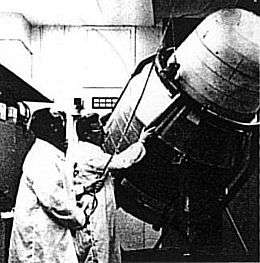Biosatellite 1
Biosatellite 1, also known as Biosat 1 and as Biosatellite A, was a first artificial satellite unmanned U.S. belonging to Biosatellite program for biological research. It was released on December 14, 1966 by a rocket Delta G from Launch Complex 17A of the Cape Canaveral Air Force Station.[4]Biosatellite 1 was the first series Biosatellite satellites. It was released in an initial orbit of 296 kilometres (184 mi) perigee 309 kilometres (192 mi) apogee and 33.5 degrees of orbital inclination, with period 90.5 minutes.
 Biosatellite 1 being prepared by scientists of the mission. | |
| Mission type | Bioscience |
|---|---|
| Operator | NASA / ARC |
| COSPAR ID | 1966-114A |
| SATCAT no. | 2632[1] |
| Mission duration | 30 days |
| Spacecraft properties | |
| Manufacturer | General Electric |
| Launch mass | 950 kg (2,090 lb) |
| Start of mission | |
| Launch date | 14 December 1966, 19:20 UTC |
| Rocket | Delta G 471/D43 |
| Launch site | Cape Canaveral LC-17A |
| End of mission | |
| Landing date | 15 February 1967[2] |
| Orbital parameters | |
| Reference system | Geocentric |
| Regime | Low Earth |
| Eccentricity | 0.00105[3] |
| Perigee altitude | 295 kilometers (183 mi)[3] |
| Apogee altitude | 309 kilometers (192 mi)[3] |
| Inclination | 33.5º[3] |
| Period | 90.5 minutes[3] |
| Epoch | 14 December 1966[3] |
Biosatellite 1 was carrying several specimens for the study of the effects of the space environment on biological processes. The capsule was returning to land separated from the vehicle properly, but its rocket didn't work, leaving it stranded in a slowly decaying orbit. It re-entered and disintegrated on February 15, 1967.
Experiments
- Effects of Weightlessness on Wheat Seedling Morphogenesis and Histochemistry
- Growth Physiology of the Wheat Seedling in Space
- Biochemical Changes in Developing Wheat Seedling in Weightless State
- Effects of Weightlessness of the Dividing Egg of Rana Pipiens
- Mutational Response of Habrobracon
- Liminal Angle of a Plagiogeotropic Organ under Weightlessness
- Effects of Radiation and Weightlessness on Tribolium Pupae
- Effects of Weightlessness on Radiation Induced Somatic Damage in Drosophila
- Effects of Space Environ on Radiation- Induced Damage to Repro Cells of Pupae
- Genetic and Cytologic Studies of Tradescantia Irradiated During Flight
- Combined Effects of Weightlessness and Radiation on Inact.+Mutation-Induct
- Spc Flt Eff-Gamma Rad Interaction on Growth+Induction of Lysogenic Bacteria
- Effects of Weightlessness on Amoeba, Pelomyxa Carolinensis[3]
References
- "1966-114A - Bios 1". lib.cas.cz. Retrieved 2018-06-14.
- "BIOSAT 1". n2yo.com. Retrieved 2018-06-14.
- "Biosatellite 1". NSSDCA. NASA GSFC. Retrieved 2018-06-14.
- "Biosatellite". Encyclopedia Astronautica. Mark Wade. Archived from the original on 2009-01-05. Retrieved 2018-06-14.